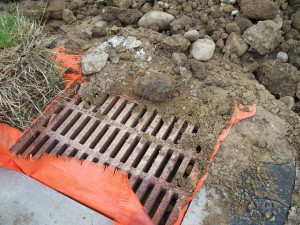Why is it important?
Construction sites are a significant contributor of sediment pollution that impacts waterways – especially the Chesapeake Bay. Eroded sediment from construction sites creates many problems in coastal areas including adverse impacts on water quality, critical habitats, submerged aquatic vegetation (SAV) beds, recreational activities, and navigation (APWA, 1991).
Runoff from construction sites is by far the largest source of sediment in urban areas under development (York County Soil and Water Conservation District, 1990). Soil erosion removes over 90 percent of sediment by tonnage in urbanizing areas where most construction activities occur (Canning, 1988). Erosion rates from natural areas such as undisturbed forested lands are typically less than one ton/acre/year, while erosion from construction sites ranges from 7.2 to over 1,000 tons/acre/year.
LaRC’s Management Strategy:
All land disturbing activities (LDA) at NASA LaRC must ensure adequate erosion and sediment controls are in place to ensure that sediment does not leave the LDA. For a complete summary of NASA LaRC’s construction and post construction management program you should read NASA LaRC’s FY22 Annual Standards and Specifications for Erosion and Sediment Control and Stormwater Management. This document is NASA’s DEQ-approved program summary. It has all the necessary information on Plan requirements, reviews, inspection, enforcement, etc. The Annual Standards and Specifications document can be obtained by contacting the LaRC Environmental Office.
DEQ Construction General Permit Coverage:
For LDAs disturbing over 1 acre of land, the activity requires coverage under the VA DEQ General VPDES Permit for Discharges of Stormwater from Construction Activities (CGP/VAR10). It is the responsibility of the Contractor to apply for the CGP coverage. The Permit will be issued in their name as the construction operator and they responsible for all fees.
Construction operators (contractors) must utilize responsible personnel and obtain certifications or qualifications for erosion and sediment control and stormwater management comparable to those required for NASA. At a minimum, operators shall have a certified Responsible Land Disturber (RLD) on staff. Prior to engaging in a LDA, the Operator must provide NASA the name of the individual holding a valid RLD Certificate who will be responsible for the land disturbance. This information and a copy of the RLD certificate is also required in the SWPPP (Stormwater Pollution Prevention Plan) submittal.
Forms for the General Permit for Discharges of Stormwater from Construction Activities
Common Issues:
Silt Fence Issues:
Inlet Protection
Concrete wash out – For more information on concrete washout and how to properly manage it, please down load the following EPA flyer: Concrete Washout Information
Helpful Tips:
- NASA will inspect your site, review your SWPPP, and require that the site is well maintained. Having your records up-to-date will help ensure compliance and avoid possible project delays
- Maintenance of your controls is critical for a successful job site. If the control is not doing its job, NASA will require the control to be maintained or replaced with a better BMP.
- Ask NASA Environmental staff for help if you need it. Environmental is eager to help ensure your site is compliant. Work with us – not against us.
Additional educational information, training presentations, and posters/flyers can be found on the Education and Outreach web page.
Note: This page links to PDF files. Use this link to download Adobe Reader if needed.




